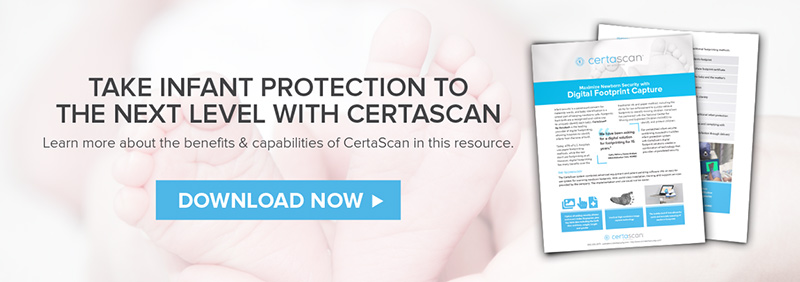
From 1965 to December of 2018, there were 325 abductions of infants confirmed by the National Center for Missing and Exploited Children (NCMEC). Of those abducted children, 140 were taken from healthcare facilities, more than any other location.
Understanding the typical profile of an abductor and the opportunities for increased security for infant protection in hospitals is key to protecting infants and reducing future abductions.
Profile of an Abductor
The NCMEC has compiled characteristics of healthcare facility abductors. These include:
- Usually a female of childbearing age who appears pregnant
- Often compulsive and relies on manipulation
- Usually lives in the community where the abduction takes place
- Frequently visits nursery and maternity units at multiple health care facilities prior to the abduction and asks detailed questions about procedures
- Usually plans the abduction, but doesn’t necessarily target a specific infant
- Frequently impersonates a nurse or other health care personnel
Remember: While these are generalizations of past abductions, there is no guarantee an infant abductor will fit this description.
Tremendous Need for Infant Security in Hospitals
With 140 infants taken from U.S. healthcare facilities since 1965, the need for infant security systems in hospitals is tremendous. As the most vulnerable patients in the hospital, ensuring infant security is critical to maintaining the hospital's reputation and providing peace of mind to nursing staff and new moms.
Arousing Suspicions
Hospital staff should be educated on the above abductor profile and should learn to be suspicious of individuals fitting the description who visit the unit repeatedly without visiting a specific patient. Inquiries about unit layouts and scheduling should also be a red flag, as well as anyone carrying large bags or packages.
Ongoing Education
Education around infant safety should be incorporated into staff training as well as mock infant abduction drills. These drills should be repeated as frequently as necessary to ensure staff is confident and comfortable in their individual roles in the case of an abduction.
Digital Footprinting
Footprints from birth are a recognized and viable way to uniquely identify each baby. CertaScan by Accutech is the leading provider of digital footprinting, allowing hospitals to identify infants from the time of birth.
Footprints are a unique identifier, which makes footprint capture an essential security feature for hospitals. However, paper footprints are messy, difficult to capture, and nearly impossible to catalog and access at a later date (and therefore not effective in identifying missing or abandoned children). With CertaScan, precise identification is enabled digitally and allows increased time efficiency for hospital staff. Plus, all footprints are saved in a digital database that law enforcement can securely access in the tragic case of a missing child.
More infants are abducted from healthcare facilities than any other location. This is a complicated issue that requires ongoing education and enhanced security efforts to combat it. Learn more about how CertaScan Digital Footprinting and the Cuddles infant protection system can help provide the greatest security available to maternity wards in this blog.
SUBSCRIBE TO OUR NEWSLETTER!
RECENT POSTS
- Enhancing Hospital Security and Efficiency: Integrating Access Control Systems with Other Security Measures
- The Link Between Visual Impairments and Alzheimer’s Disease: Insights from UCSF Study
- Network-Dependent Patient Elopement Systems: Unveiling Risks and Vulnerabilities in Healthcare Security
- 5 Common Causes of Patient Elopement
- Ensuring Newborn Safety: Modern Hospital Security Measures
- Hospital Bag Checklist
- Everything You Need to Know About Infant Hospital ID Bracelets
- Top 5 Best Practices for Infant Security in Hospitals
- Where Do Most Infant Abductions Occur?
- How Does The Accutech Wandering System Work?
RECENT POSTS
- Enhancing Hospital Security and Efficiency: Integrating Access Control Systems with Other Security Measures
- The Link Between Visual Impairments and Alzheimer’s Disease: Insights from UCSF Study
- Network-Dependent Patient Elopement Systems: Unveiling Risks and Vulnerabilities in Healthcare Security
- 5 Common Causes of Patient Elopement
- Ensuring Newborn Safety: Modern Hospital Security Measures
- Hospital Bag Checklist
- Everything You Need to Know About Infant Hospital ID Bracelets
- Top 5 Best Practices for Infant Security in Hospitals
- Where Do Most Infant Abductions Occur?
- How Does The Accutech Wandering System Work?

